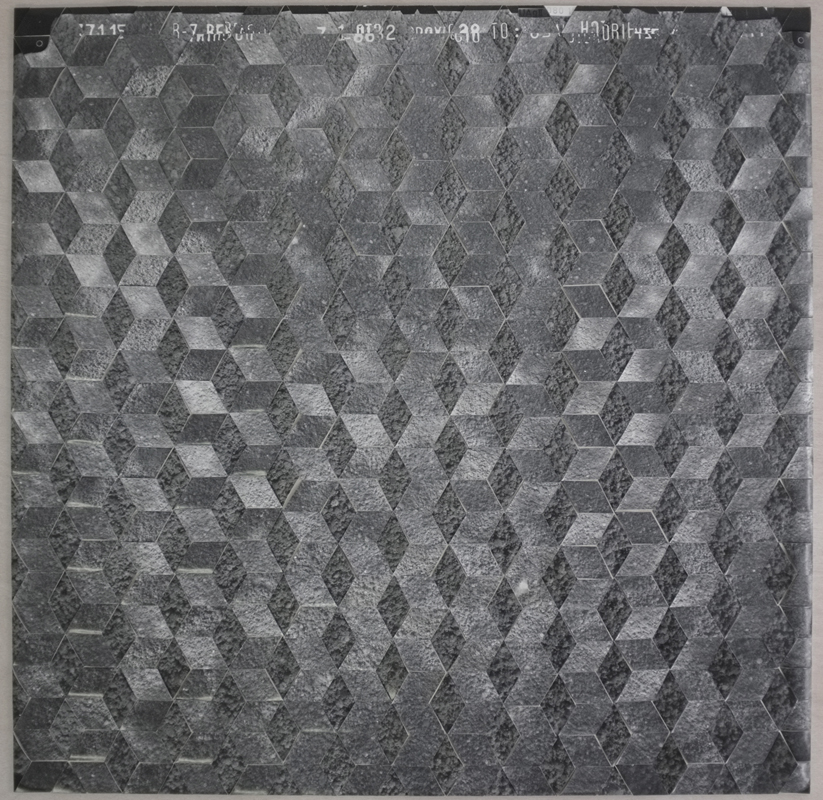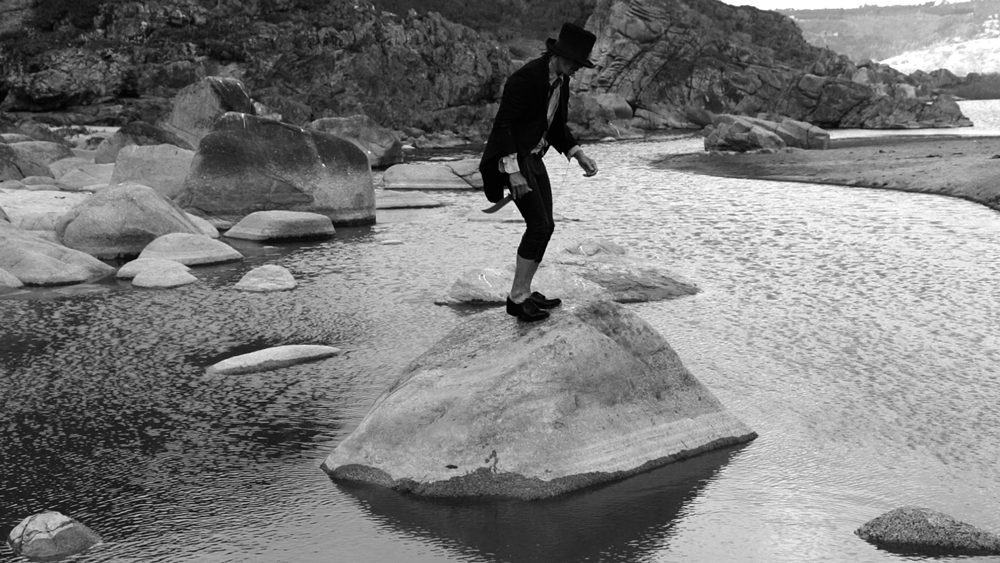
© » KADIST
Jorge Satorre
In 1872, a German scientist, Sir Julius von Haast, found the fossilized remains of a giant bird in New Zealand, that was soon connected to the Maori legend of the Hokioi. The Maori folklore recounts the story of an eagle of immense proportions that was said to be capable of devouring human beings. The bones uncovered by the scientist included a femur, one rib, and two claws.

© » KADIST
Leelee Chan
Blindfold Receptor (caterpillar-yellow) by Leelee Chan is inspired by the camouflaging nature of the peppered-moth caterpillar. In 1800s Europe, during the industrial revolution, light-colored moths evolved into a darker color after trees in their habitat darkened by the polluting soot. Today, due to rapid human changes to the environment, caterpillars can adapt even before they metamorphose into moths, mimicking the colour of the branches they inhabit.

© » KADIST
Carlos Fernández
Part of the exhibition PIÑA MATRIZ (2014) at Despacio Art, this untitled work by Carlos Fernández is a wood panel (formerly a section of a wooden table top) that bears the residue of insects interacting with fermented pineapple. The exhibition considered the production of pineapple monocultures and the agricultural monopolies for this product. Fernández used the exhibition space to portray alternative possibilities of diversified and ecologically sustainable production that could be mobilized in place of mass produced pineapple monocultures.
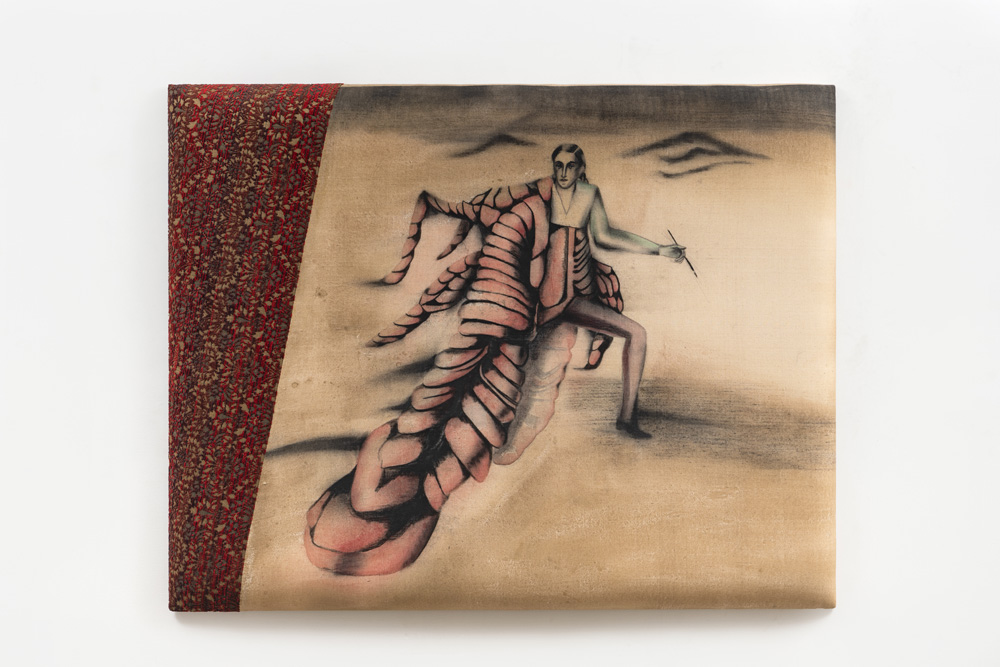
© » KADIST
Anju Dodiya
The Shedding by Anju Dodiya is part of a series of mattress paintings the artist creates using fabric stretched on padded and shaped boards. The imagery relates to other paintings in this body work that expresses the visceral and vulnerable side of creativity. The posture of the protagonist—a part-human, part-carapaced animal—is opening herself outwardly.

© » KADIST
Rometti Costales
Canción para un fósil canoro (Song for a chanting fossil) by Rometti Costales is inspired by the history of the building that currently hosts the Museo de la Solidaridad Salvador Allende (MSSA) in Santiago, Chile. The duo associated the layers of the building’s history with the vestiges of life and the processes of fossilization that have taken place in areas of the Atacama Desert, a territory that has been the stage for several episodes in Chile’s tumultuous economic and political history. The work operates as a metaphor for the strata of historical memory, condensing different materials and operations.

© » KADIST
Curran Hatleberg
Untitled (Man with Bees) is part of Curran Hatleberg’s attempt to make sense of the current state of the “American Dream”, or lack thereof. “Without question our present American experience feels increasingly strange, unnerving and dreamlike. Our country is utterly different and changed now in its present iteration – surreal and confounding – and we can’t help but regard it with a confounded stare that we hold in reserve for the most bizarre and difficult circumstances.” This image is one, like many in the series that find something poetic, supernatural, and surreal in the common human condition of middle America.

© » KADIST
Sung Hwan Kim
Drawing & Print (Drawing & Print)
This untitled drawing was part of Sung Hwan Kim’s solo exhibition Sung Hwan Kim: A Still Window From Two or More Places , which took place in tranzitdisplay in Prague, Czech Republic in 2010. tranzit.cz is part of a network working independently in Austria, the Czech Republic, Hungary, Slovak Republic, and Romania since 2002. Such doodle-like drawings are often crucial components of Kim’s performances. The imagery of faces, heads, snakes, and serpentine paths are recurring motifs in the artist’s drawing practice.
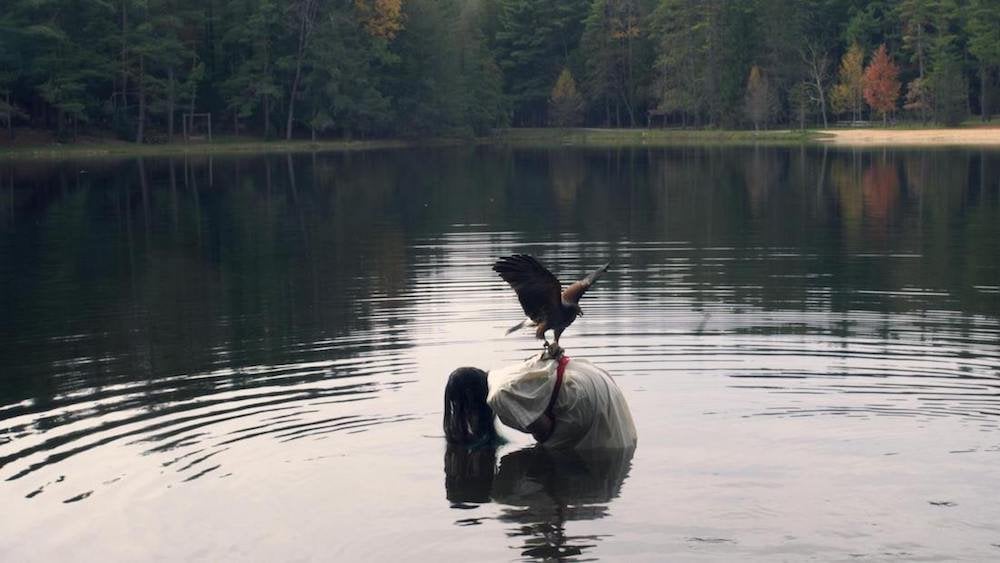
© » KADIST
Alicia Smith
The title of Alicia Smith’s video work, Teomama , means “God Carrier” in the Aztec language of Nahuatl. It was the name given to medicine men and women who carried the bones of Huitzilopochtli—the god of war, sun, and human sacrifice in ancient Mexico, and the national deity of the Aztecs. Of the many legends featuring Huitzilopochtli, the origin story of Tenochtitlan (present day Mexico City) is perhaps one of the most well-known.

© » KADIST
Auriea Harvey
Fauna is a figurative sculpture by Auriea Harvey that is characteristic of the artist’s practice—both serious and somewhat whimsical. Making use of old and new technologies, the work is a self-portrait. The sculpture features a soft and gentle human face made of 3D printed composite, sprouting from a clutter of clay and other materials.

© » KADIST
Ana Vaz
Ana Vaz describes her film É Noite na América (It is Night in America) as an eco-terror tale, freely inspired by A cosmopolitics of animals by Brazilian philosopher Juliana Fausto; in which she investigates the political life of non-human beings and questions the modern idea of the exceptionality of the human species. In parallel to the feature film version, Vaz created a three-channel installation format meant to be displayed in contemporary art spaces. This edition includes three complementary video works that expand on the conceptual frameworks of the film.

© » KADIST
Luiz Roque
In Luiz Roque’s short film Zero we follow a dog moving alone onboard an aircraft that flies over a vast desert. The dog seems tranquil as if keeping up with its daily routine in an environment in which the human presence is completely absent. The disturbing image of the animal left adrift — perhaps the only remaining living being in existence — is interspersed with the shiny mirrored surface of high-tech skyscrapers emerging out of the sand, in what might have once been an oasis.
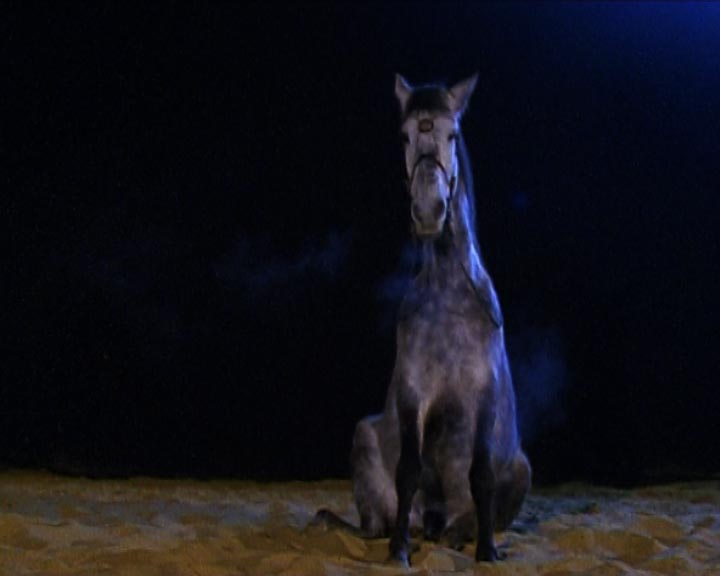
© » KADIST
Carolina Saquel Martinez
The artist films a horse dressage session at night, in a dimly lit manège. In this video the artist recalls the importance of traditional equestrian portraits in Spanish painting and relates to the repetitive passage between the rider and the mount. This effect of repetition is accentuated by the video played in a loop and the fixed framing of the image shot from the ground, with body posture and dressage themes as a method for training and obedience.

© » KADIST
Gabriel Pericas
“Weight & velocity (cat on router)” is a duo of two humorous photographs of a cat lying on a computer router. The weight of the cat that voluptuously outspreads on the router contrasts with the speed of the information circulating in the object—the two subjects are opposing in their essential existence. In a pragmatic way, the cat stretches on the router for the heat that emerges.

© » KADIST
Karrabing Film Collective
The Mermaids, or Aiden in Wonderland by Karrabing Film Collective is a surreal exploration of Western toxic contamination, capitalism, and human and non-human life. Set in a land and seascape poisoned by capitalism where only Aboriginals can survive long periods outdoors, the film tells the story of a young Indigenous man, Aiden, taken away when he was just a baby to be a part of a medical experiment to save the white race. He is then released back into the world to his family.

© » KADIST
Gary-Ross Pastrana
Gary-Ross Pastrana’s video installation Rewilding consists of three large-scale projections placed across the exhibition space. The poetic footage filmed by the artist portrays three interconnected worlds: a colony of termites; a piano repair workshop in the outskirts of Manila; and an empty concert theatre. Their interconnectivity is shaped by the voice-over of three narrators: a musician discussing the balance between order and chaos found in classical music; a piano repairman describing termite infestations in an instrument of European origin; and a scientist describing the unique social structures of this tropical parasite.

© » KADIST
Sung Hwan Kim
Drawing & Print (Drawing & Print)
This untitled drawing was part of Sung Hwan Kim’s solo exhibition Sung Hwan Kim: A Still Window From Two or More Places , which took place in tranzitdisplay in Prague, Czech Republic in 2010. tranzit.cz is part of a network working independently in Austria, the Czech Republic, Hungary, Slovak Republic, and Romania since 2002. Such doodle-like drawings are often crucial components of Kim’s performances. The imagery of faces, heads, snakes, and serpentine paths are recurring motifs in the artist’s drawing practice.

© » KADIST
Sergio Rojas Chaves
Más vale pájaro en mano que cien volando (A bird in the hand is worth more than two in the bush) is part of a larger series of pieces developed by Sergio Rojas Chaves in Honduras in 2018 that engages with tourism and in particular amateur-ornithologists that overrun the country in pursuit of the nation’s extreme diversity of bird species. The works include a performance in which artist Sergio Rojas Chaves, dressed like a bird, observes the ornithologists as if they too are birds, another work features an audio recording of amateur ornithologists imitating bird sounds in the jungle of Honduras. This series of photographs was taken during an amateur-ornithologist research trip.

© » KADIST
Robert Zhao Renhui
The photograph Proxy II (Beetles) by Robert Zhao Renhui belongs to a series, titled Christmas Island, Naturally, that focuses on the ecology of Christmas Island; a remote volcanic land formation in the Indian Ocean. Since the first settlements in the late 19th century, the ecosystems of Christmas Island have undergone devastating alterations. After nearly 150 years of human settlement, a number of invasive species have been unwittingly introduced to the island.

© » KADIST
Davida Nemeroff
In one series, she considers issues of spectatorship at the Los Angeles Zoo. Box Stall (2013) shows the back end of a horse, highlighting what is included and excluded from the frame of vision.

© » KADIST
Sam Contis
Sam Contis’s photographs explore the relationship of bodies to landscape, and the shifting nature of gender identity and expression. Horseback is part of a photographic series Contis made at Deep Springs College, one of the United States’s last all-male institutions of higher learning, located in a remote desert valley on the California–Nevada border. Horseback is a black and white photograph that depicts the arched shoulders of a horse, its slick mane splayed across its neck.

© » KADIST
Tania Candiani
“There is a tapestry of sounds around us.” – Tania Candiani Tania Candiani has long been interested in Acoustic Ecology: the study of relationships between humans and our environment mediated through sound. A poetic text by Candiani narrated by writer and MacArthur fellow Josh Kun is featured in this three-channel video, For the Animals. The artist carried out visual research for the project: scanning, sampling and borrowing from books, vintage videos and images of material that informed her process.

© » KADIST
Danaya Chulphuthiphong
The film Demos by Danaya Chulphuthiphong draws parallels between zoo animals and humans through an assemblage of footage and images collected from various news and science websites. The soundtrack, made in collaboration with filmmaker, artist, and musician Pathompon “Mont” Tesprateep, was also sourced online and includes recordings of sounds produced in outer space, underwater, the deep jungle, as well by drones and laser beams. The film begins with the watchful eye of a semi-submerged crocodile, then shifts into an industrial scene of cranes swinging building materials across the sky.

© » KADIST
Jeamin Cha
Jeamin Cha’s essay-film Ellie’s Eye is an extensive examination of the human mind and the effects of new technology, such as chatbots and virtual avatar therapists on the mental health industry. One such avatar, named Ellie, was developed by the University of Southern California’s Institute for Creative Technologies. Ellie has the ability to interpret the user’s emotions through data collected from their speech and physical gestures to indicate psychological distress on a micro-level, which would be imperceptible by a human therapist.

© » KADIST
Robert Zhao Renhui
Created during Zhao Renhui’s residency at Kadist SF in 2014, Zhao Renhui began observing and cataloguing insects inspired by the scientific impulse towards exhaustive taxonomy of Sacramento-based Dr. Martin Hauser, Senior Insect Biosystematist at the California Department of Food and Agriculture, and longtime acquaintance of the artist. In Villa Dei Fiori, September to November, Zhao Renhui tracked and collected multiple insects within the everyday urban environment, either finding the insects dead or following them around for few days.

© » KADIST
Rachel Rose
In the 2013 video work, Sitting Feeding Sleeping , Rose combines footage taken of zoo animals living in captivity with screen images that flicker and flash before us. In the narration, Rose talks about forms of life that are suspended and simulated—artificial intelligence and cryogenically frozen bodies, zoo animals and counterfeit ecologies. Through this montage of different types of footage and text, Rose poses us between the natural and the artificial, and speaks to the very strange moment of life in a world that is seemingly caught between the two, existing in a hybrid (though not necessarily symbiotic) moment of radical change.

© » KADIST
Jakob Kudsk Steensen
Advanced Technology (Advanced Technology)
RE-ANIMATED by Jakob Kudsk Steensen revolves around the haunting sound of the Kauai’O’o, a bird that became extinct in the year of Steensen’s birth. Its mating call, recorded and circulated on YouTube, where it has attracted hundreds of thousands of views and thousands of comments from viewers who felt the need to share their own emotional connection with this creature. For Steensen, the video exemplifies the way in which digital media experiences can serve as a memorial for a disappearing natural world, and how they can activate deeply felt connections with nonhuman creatures.

© » KADIST
Rivane Neuenschwander
In this video, a parrot chews on seeds printed with punctuation marks. A radio on the shelf in the background broadcasts the news of an unfolding football match. As the game (and video) progresses, the bird eats all of the remaining punctuation.

© » KADIST
Pedro Reyes
Pedro Reyes’s Los Mutantes ( Mutants , 2012) is composed of 170 plates that combine characters from ancient and modern mythologies. As in a periodic table, animals and objects are combined with humans (male or female), providing a rational framework for the irrational products of human imagination. A Cartesian matrix such as this must follow certain rules.
Sung Hwan Kim
In his practice, Sung Hwan Kim assumes the role of director, editor, performer, composer, narrator, and poet...
Robert Zhao Renhui
Robert Zhao Renhui’s multimedia practice questions fact-based presentations of ecological conservation and reveals the manner in which documentary, journalistic, and scientific reports sensationalize nature in order to elicit viewer sympathy...
Pedro Reyes
- location: Mexico City, Mexico
- year born: 1972
- gender: male
- nationality: Mexican
- home town: Mexico City, Mexico
Luiz Roque
Brazilian artist Luiz Roque’s production consists largely of short duration open-ended cinematic narratives, in which he places mysterious characters (either gender-fluid dancers, famous drag queens, animals, landmark modernist buildings or historical artworks) creating dreamlike and sci-fi atmospheres...
Jakob Kudsk Steensen
Jakob Kudsk Steensen employs a formally rigorous approach to creating multi-layered VR environments that engage with the contemporary issue of extinction...
Anju Dodiya
Anju Dodiya paintings feature autobiographical and human relationships, with ‘women’ usually at the center...
Auriea Harvey
Committed to technique and the mastery of tools, for decades Auriea Harvey’s practice has included drawing, sculpting, and software coding...
Rometti Costales
Rometti Costales is an artistic collaboration between Julia Rometti and Victor Costales that began in 2007...
Davida Nemeroff
Davida Nemeroff turns her camera toward scenes from everyday life, creating compositions within the frame of her lens that are strong, even introspective...
Carolina Saquel Martinez
Caroline Saquel was born in Chile and now lives and works in Paris...
Jorge Satorre
Jorge Satorre’s practice prioritizes manual processes and experiments with different materials in specific historical or geographical contexts...
Alicia Smith
Alicia Smith is a Xicana artist and activist whose work thoughtfully engages with the subjects of indigeneity, colonialism, the environment, and the female body...
Ana Vaz
Ana Vaz is an artist and filmmaker whose works speculate on the relationships between self and other, and myth and history, through a cosmology of signs, references, and perspectives...
Leelee Chan
Working in sculpture, Leelee Chan’s visual vocabulary reflects her subjective experience of the extreme urbanization in Hong Kong by proposing a dialogue between concrete materiality, found in heavy industry, and poetics found in ceramics, and its cultural archaeology in millinery Chinese history...
Gary-Ross Pastrana
Gary-Ross Pastrana is an artist interested in the philosophies of art and the epistemologies of the art object...
Carlos Amorales
- year born: 1970
- gender: male
- nationality: Mexican
- home town: Mexico City, Mexico
Gabriel Pericas
Gabriel Pericàs (b...
Danaya Chulphuthiphong
Working with both still and moving images, Danaya Chulphuthiphong is an activist and filmmaker whose work sheds light on social realities in Thailand...
Karrabing Film Collective
Karrabing Film Collective is an indigenous media group consisting of over 30 members, bringing together Aboriginal filmmakers from Australia’s Northern Territory...
Rachel Rose
Rachel Rose is a visual artist known for her video installations that merge moving images and sound within nuanced environments connecting them to broader subjects...
Tania Candiani
Artist Tania Candiani works at the intersection of language, sound and technology, often mixing outdated devices such as typewriters or Victrolas with new custom-made electronics to create large-scale sculptures and installations...
Sergio Rojas Chaves
Sergio Rojas Chaves’s work focuses on contemporary depictions of animals and of plants and affective approaches to biology...
Jeamin Cha
Jeamin Cha’s questions exist in the gyre between individual and social environment, stepping over conspicuous strands of relation between the two in favor of cultivating characters that dwell in the night, under-noticed or otherwise surplus figures outside of mainstream societal representation...
Curran Hatleberg
Curran Hatleberg spends extended amounts of time with his subjects, usually months, building a rapport, building trust, until finally making images with them...
-
-
2010-2019
Sung Hwan Kim
Drawing & Print
2010(Drawing & Print) This untitled drawing was part of Sung Hwan Kim’s solo exhibition Sung Hwan Kim: A Still Window From Two or More Places , which took place in tranzitdisplay in Prague, Czech Republic in 2010...
Sung Hwan Kim
Drawing & Print
2010(Drawing & Print) This untitled drawing was part of Sung Hwan Kim’s solo exhibition Sung Hwan Kim: A Still Window From Two or More Places , which took place in tranzitdisplay in Prague, Czech Republic in 2010...
Pedro Reyes
2012Pedro Reyes’s Los Mutantes ( Mutants , 2012) is composed of 170 plates that combine characters from ancient and modern mythologies...
Rachel Rose
2013In the 2013 video work, Sitting Feeding Sleeping , Rose combines footage taken of zoo animals living in captivity with screen images that flicker and flash before us...
Carlos Fernández
2014Part of the exhibition PIÑA MATRIZ (2014) at Despacio Art, this untitled work by Carlos Fernández is a wood panel (formerly a section of a wooden table top) that bears the residue of insects interacting with fermented pineapple...
Gabriel Pericas
2014“Weight & velocity (cat on router)” is a duo of two humorous photographs of a cat lying on a computer router...
Sam Contis
2014Sam Contis’s photographs explore the relationship of bodies to landscape, and the shifting nature of gender identity and expression...
Robert Zhao Renhui
2014Created during Zhao Renhui’s residency at Kadist SF in 2014, Zhao Renhui began observing and cataloguing insects inspired by the scientific impulse towards exhaustive taxonomy of Sacramento-based Dr...
Robert Zhao Renhui
2016The photograph Proxy II (Beetles) by Robert Zhao Renhui belongs to a series, titled Christmas Island, Naturally, that focuses on the ecology of Christmas Island; a remote volcanic land formation in the Indian Ocean...
Danaya Chulphuthiphong
2016The film Demos by Danaya Chulphuthiphong draws parallels between zoo animals and humans through an assemblage of footage and images collected from various news and science websites...
Curran Hatleberg
2017Untitled (Man with Bees) is part of Curran Hatleberg’s attempt to make sense of the current state of the “American Dream”, or lack thereof...
Alicia Smith
2018The title of Alicia Smith’s video work, Teomama , means “God Carrier” in the Aztec language of Nahuatl...
Auriea Harvey
2018Fauna is a figurative sculpture by Auriea Harvey that is characteristic of the artist’s practice—both serious and somewhat whimsical...
Karrabing Film Collective
2018The Mermaids, or Aiden in Wonderland by Karrabing Film Collective is a surreal exploration of Western toxic contamination, capitalism, and human and non-human life...
Gary-Ross Pastrana
2018Gary-Ross Pastrana’s video installation Rewilding consists of three large-scale projections placed across the exhibition space...
Sergio Rojas Chaves
2018Más vale pájaro en mano que cien volando (A bird in the hand is worth more than two in the bush) is part of a larger series of pieces developed by Sergio Rojas Chaves in Honduras in 2018 that engages with tourism and in particular amateur-ornithologists that overrun the country in pursuit of the nation’s extreme diversity of bird species...
Jakob Kudsk Steensen
Advanced Technology
2018(Advanced Technology) RE-ANIMATED by Jakob Kudsk Steensen revolves around the haunting sound of the Kauai’O’o, a bird that became extinct in the year of Steensen’s birth...
Jorge Satorre
2019In 1872, a German scientist, Sir Julius von Haast, found the fossilized remains of a giant bird in New Zealand, that was soon connected to the Maori legend of the Hokioi...
Leelee Chan
2019Blindfold Receptor (caterpillar-yellow) by Leelee Chan is inspired by the camouflaging nature of the peppered-moth caterpillar...
Rometti Costales
2019Canción para un fósil canoro (Song for a chanting fossil) by Rometti Costales is inspired by the history of the building that currently hosts the Museo de la Solidaridad Salvador Allende (MSSA) in Santiago, Chile...
Luiz Roque
2019In Luiz Roque’s short film Zero we follow a dog moving alone onboard an aircraft that flies over a vast desert...
-
2020-2029
Tania Candiani
2020“There is a tapestry of sounds around us.” – Tania Candiani Tania Candiani has long been interested in Acoustic Ecology: the study of relationships between humans and our environment mediated through sound...
Jeamin Cha
2020Jeamin Cha’s essay-film Ellie’s Eye is an extensive examination of the human mind and the effects of new technology, such as chatbots and virtual avatar therapists on the mental health industry...
Anju Dodiya
2022The Shedding by Anju Dodiya is part of a series of mattress paintings the artist creates using fabric stretched on padded and shaped boards...
Ana Vaz
2022Ana Vaz describes her film É Noite na América (It is Night in America) as an eco-terror tale, freely inspired by A cosmopolitics of animals by Brazilian philosopher Juliana Fausto; in which she investigates the political life of non-human beings and questions the modern idea of the exceptionality of the human species...




